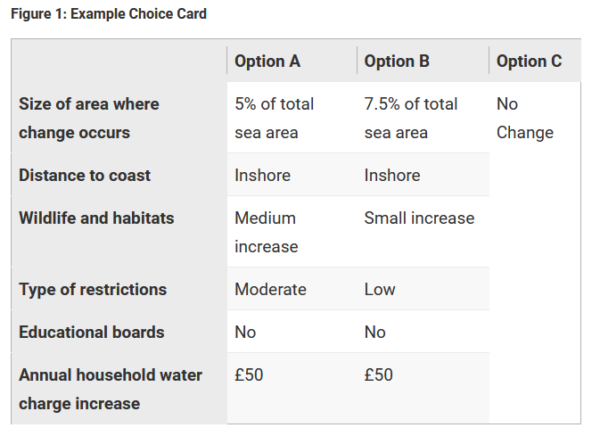A report summarising the results of a choice experiment survey that was designed to capture the preferences of Scottish people towards the management of marine and coastal areas in Scotland has been published by the Scottish Government. The study was carried out to improve understanding of the economic value people place on key environmental and management characteristics of marine and coastal areas in Scotland. A stated-preferences choice experiment was designed to quantify this value.
In the choice experiment, respondents were asked to select their preferred option for alternative management policies, which were described in terms of 6 attributes:
- Size of area where change occurs
- Distance to coast
- Wildlife and habitats
- Type of restrictions
- Educational public display boards
- Annual household water charge increase
Most respondents reported to have had positive personal experiences of Scotland’s marine wildlife and habitats, with 61% rating their experiences ‘very good’ or ‘good’. 19% of respondents thought that the environmental condition of marine and coastal areas in Scotland had improved in the past 5 years, while 36% thought it had stayed the same, 33% thought it had worsened and 11% said they did not know.
The majority of respondents (76%) had visited a marine or coastal area in Scotland in the last 12 months. 20% stated that although they had not visited in the last 12 months they had before and only 4% of respondents had never visited. ‘Enjoying the natural environment’, ‘Walking opportunities’ and ‘Being able to see wildlife in the area’ were the top 3 factors respondents considered when deciding which area to visit.
Key findings include:
- Overall, results from the choice experiment suggest that people in Scotland are supportive of management policies in marine and coastal areas over doing nothing.
- People in Scotland hold significant values for management policies that result in larger areas changed, larger increases in wildlife and habitats, ‘low’ and ‘moderate’ levels of restrictions, and additional educational content.
- People who have visited a marine and coastal area in the last 12 months, do regular recreational activities, are younger or have a marine industrial connection tend to have stronger preferences for alternative management options over the status quo.
- Households in Scotland are estimated to be willing to pay a total of between £90m-£132m per year (£35-£52 per household) for management policies that result in a ‘large increase’ in wildlife and habitats, decreasing to £40m-£80m per year (£16-£32 per household) for a ‘medium’ increase.
- For every additional 1% of total sea area changed by management policies, households are estimated to be willing to pay an additional £2m-£8m per year (£1-£3 per household).
To read the full report click here.
